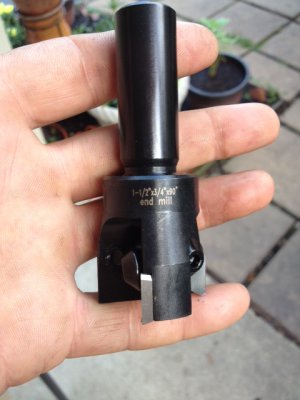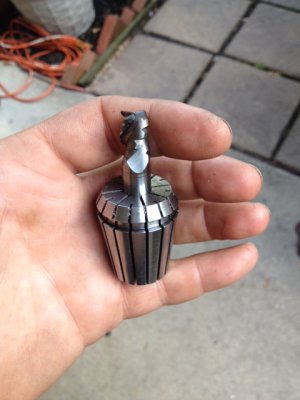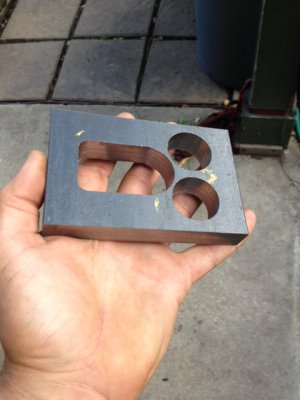- Joined
- May 7, 2014
- Messages
- 776
Hi everyone, As many know my Son and I are total newbies on the Milling /CAM/CNC side. Came over from Plasma & 2.5 work.
What we have : My kid and I have a 3:1 combo 2hp Mill Drill Lathe setup.
What we are machining: 1045 steel (small pics attached) w/ only small workloads (or so I thought).
cutter= IMCO 525 5/8 and a 1/2 combo rougher/Finish Both tried w/ maybe moderate success.
Here is the issue: (remember, it's only been about 1 month on our OJT here. ;-) I keep chipping the corners off my end mills. chatter and vibration seem abundant. I simply cannot continue to experiment upon this level of steel hardness and ruin pricey hard steel cutters. The Son is young and thinks this will work. I'm starting to think we should go mild steel and try to harden post milling? He is trying to start his own business so I'm trying not to discourage him into a different product just yet. (he's 17).
I'm reading and experimenting about harder steel milling and wanted to ask something. Are Mill cuts in the .02-.05 WOC/DOC range seemingly OK if that's what it takes? It seems to me that I should be able to get some better cutting than this? Feedrate is 5 to 8 and far from the GWizard and Imco specs in the 20's and 30's. chip-loads in the .0012 range. (should be high 20's / low 30's). but I keep the SFM dialed as best I can.
Specs: I have the RPM to 1100-1300 w/ 1/3-1/2 chiploads as a full chip-load seems to chatter like crazy. Width is usually just a .04-.07 step-over. Depth of cutter is about .06 tops. This seems to allow me to get thru the material albeit really slow. I now started to setup DolphinCam to just go around 2x or 3x to get me into the -.1 depth range w/ .03 depth passes. that's 1hour-30mins to mill out 1 axe face side.
What is My question: Does this seem like we're on track with this? All we are doing is a Z ramp cut from -0.00 down to -.09-.1 in multiple passes. To me it seems like the corners are taking a beating while ramping down into material and maybe passing a tiny tiny load onto the flute sides (my assumption here). I tried a ball mill just to compare and it tore the cutter head clean off when it hit face edges. Bad idea.... Not sure a Corner radius would help? Just a blunted corner slamming into the edges as it slopes down in. Maybe a grinder would be easier, but hey - We're having fun together and that counts for a bunch!
Anyone like the insert style cutters? Maybe he would have better luck and predictability of cut parms with those? I cannot find too many articles or suggestions for plasma cut 1045 w/ lower end hobby mills. ....And I'm starting to see why.
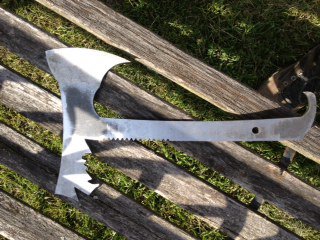
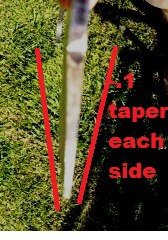


What we have : My kid and I have a 3:1 combo 2hp Mill Drill Lathe setup.
What we are machining: 1045 steel (small pics attached) w/ only small workloads (or so I thought).
cutter= IMCO 525 5/8 and a 1/2 combo rougher/Finish Both tried w/ maybe moderate success.
Here is the issue: (remember, it's only been about 1 month on our OJT here. ;-) I keep chipping the corners off my end mills. chatter and vibration seem abundant. I simply cannot continue to experiment upon this level of steel hardness and ruin pricey hard steel cutters. The Son is young and thinks this will work. I'm starting to think we should go mild steel and try to harden post milling? He is trying to start his own business so I'm trying not to discourage him into a different product just yet. (he's 17).
I'm reading and experimenting about harder steel milling and wanted to ask something. Are Mill cuts in the .02-.05 WOC/DOC range seemingly OK if that's what it takes? It seems to me that I should be able to get some better cutting than this? Feedrate is 5 to 8 and far from the GWizard and Imco specs in the 20's and 30's. chip-loads in the .0012 range. (should be high 20's / low 30's). but I keep the SFM dialed as best I can.
Specs: I have the RPM to 1100-1300 w/ 1/3-1/2 chiploads as a full chip-load seems to chatter like crazy. Width is usually just a .04-.07 step-over. Depth of cutter is about .06 tops. This seems to allow me to get thru the material albeit really slow. I now started to setup DolphinCam to just go around 2x or 3x to get me into the -.1 depth range w/ .03 depth passes. that's 1hour-30mins to mill out 1 axe face side.
What is My question: Does this seem like we're on track with this? All we are doing is a Z ramp cut from -0.00 down to -.09-.1 in multiple passes. To me it seems like the corners are taking a beating while ramping down into material and maybe passing a tiny tiny load onto the flute sides (my assumption here). I tried a ball mill just to compare and it tore the cutter head clean off when it hit face edges. Bad idea.... Not sure a Corner radius would help? Just a blunted corner slamming into the edges as it slopes down in. Maybe a grinder would be easier, but hey - We're having fun together and that counts for a bunch!
Anyone like the insert style cutters? Maybe he would have better luck and predictability of cut parms with those? I cannot find too many articles or suggestions for plasma cut 1045 w/ lower end hobby mills. ....And I'm starting to see why.





